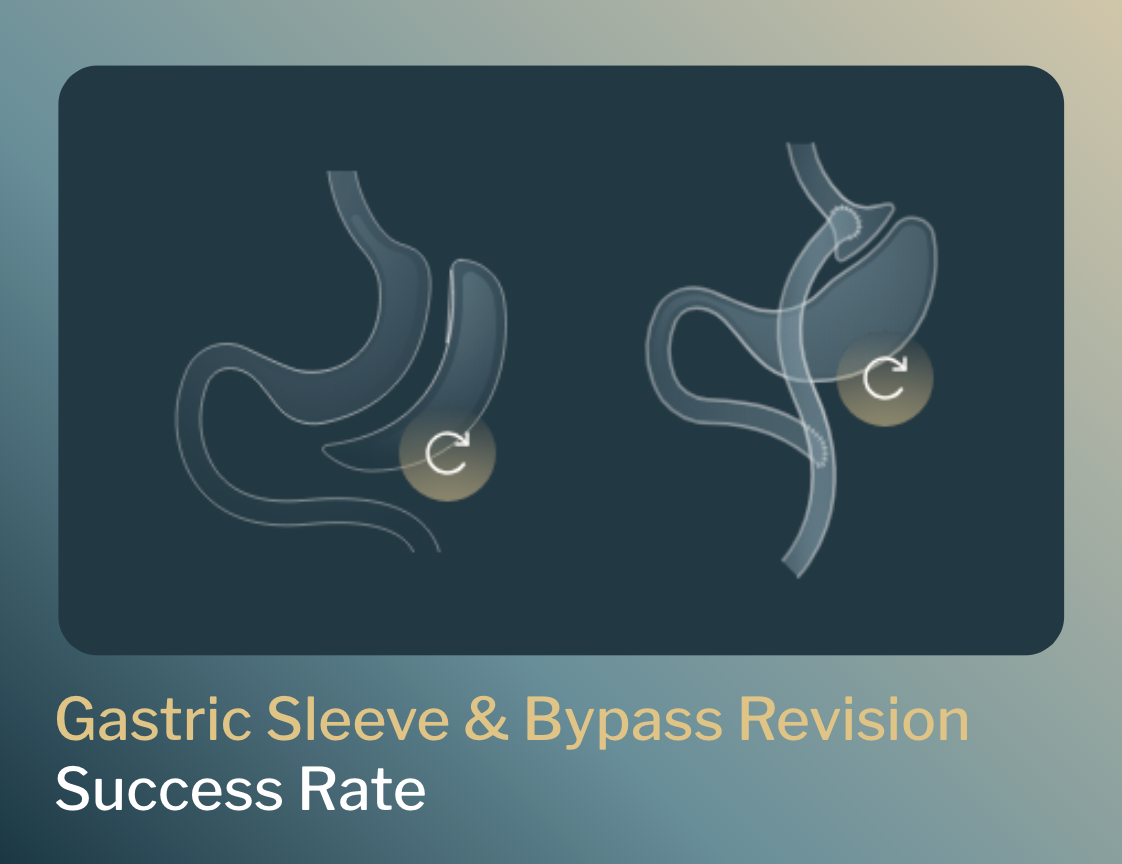Sleeve to Bypass Revision: How Much Weight Do You Lose?
How much weight do you lose with revision from sleeve to bypass? Learn about the weight loss potential of revision surgery and explore your options.


Co-founder, SVP of Longitudinal Care
Wondering how much weight you can lose with revision from sleeve to bypass? For patients who don’t see the results they expected after a sleeve gastrectomy, revision procedures can be life changing. By restoring the effects of your initial surgery, these procedures offer a second chance at achieving sustainable weight loss.
Below, we’ll explore how much weight you can lose with a surgical sleeve-to-bypass revision and what to expect. We’ll also compare these outcomes to endoscopic gastric sleeve revision - a non-invasive alternative - to help you understand which approach might be right for you.
How Much Weight Do You Lose with Revision from Sleeve to Bypass?
A sleeve-to-bypass revision can help patients regain momentum in their weight loss journey. This surgery is designed to further restrict the amount of food you can eat at one time while also altering the way your body processes food and absorbs nutrients.
Average Weight Loss After Sleeve-to-Bypass Surgery
Patients who undergo sleeve-to-bypass revision surgery often experience significant weight loss, with many losing 10-15% of their body weight within one year of the procedure. However, success largely depends on following post-surgery guidelines, including eating smaller portions, maintaining a nutrient dense diet, and leading an active lifestyle.
While results can vary, the additional weight loss achieved through this procedure can have a transformative impact on overall health, improving weight related conditions like Type 2 diabetes, hypertension, and sleep apnea. This is especially beneficial for patients who struggled to achieve a healthy weight after their initial gastric sleeve surgery.
What Happens in a Sleeve to Bypass Revision?
During a sleeve to bypass revision surgery, the stomach sleeve created in the initial surgery is converted to a smaller pouch. A portion of the small intestine is also rerouted to bypass part of the digestive system, limiting the absorption of calories and nutrients.
This process supports weight loss by limiting food intake and regulating hunger hormones to reduce appetite. The procedure is performed laparoscopically and requires a short hospital stay followed by several weeks of recovery before resuming exercise and other daily activities.
Benefits and Limitations of Surgical Sleeve-to-Bypass
A sleeve-to-bypass revision surgery not only helps patients lose more weight and improve weight related health conditions, but also improves the patient’s overall quality of life. Many patients report increased energy levels and improved self-esteem over time.
However, this surgery is more complex than the original procedure and carries a higher risk of complications. Patients must also commit to lifelong dietary changes, including taking vitamin and mineral supplements daily to prevent deficiencies caused by reduced nutrient absorption.
Who Typically Chooses Surgical Sleeve-to-Bypass Revision?
Patients who choose a sleeve-to-bypass revision surgery typically fall into two main categories: those who have experienced significant weight regain after their initial surgery and those who experienced complications like severe acid reflux or GERD. In some cases, this surgery may also be suggested for patients who need a more robust solution to their weight loss challenges.
Before deciding on a conversion from gastric sleeve to bypass, patients will undergo a thorough evaluation to assess their current health status, medical history, and readiness to commit to the lifestyle changes required for success.
How Much Weight Can You Lose with Endoscopic Sleeve Revision?
Endoscopic gastric sleeve revision, called Sleeve-In-Sleeve (SIS), is a non-invasive procedure designed to help patients restart their weight loss journey after an unsuccessful sleeve gastrectomy. By re-tightening the stomach sleeve, this procedure helps patients achieve additional weight loss without the long recovery time and risks associated with sleeve-to-bypass revision surgery.
Average Weight Loss After Sleeve-In-Sleeve (SIS) Revision
Patients who undergo the Sleeve-In-Sleeve revision procedure typically experience an average of 15% weight loss, which is comparable to surgical options. The success rate for this 30-45 minute procedure is very high, with 82% of participants losing at least 10% body weight.
Success of this procedure depends on the patient’s commitment to a healthy lifestyle, attending regular follow-up appointments, and maintaining a strong support system.
What Happens During an Endoscopic Sleeve-In-Sleeve Revision?
Sleeve-In-Sleeve revision is performed endoscopically, meaning it requires no external incisions or invasive surgery. During the procedure, a small endoscope is inserted through the mouth and into the stomach with advanced tools attached. The surgeon re-tightens the stomach sleeve by placing sutures to reduce its size and restore restriction.
The entire procedure takes between 30-45 minutes and is performed on an outpatient basis. Patients can go home the same day and return to work and normal activities, including exercise, within a few days. By restoring the stomach’s restrictive size, this procedure helps patients feel fuller sooner and stay satisfied longer. It also regulates hunger hormones, aiding in appetite control and reducing cravings.
Benefits and Limitations of Endoscopic Gastric Sleeve Revision
Endoscopic gastric sleeve revision offers several key advantages for patients looking to restart weight loss. The procedure requires no external incisions, which means no scarring, less pain, a faster recovery time, and a lower risk of complications.
The procedure’s ability to regulate hunger hormones is also a significant benefit for those who have struggled to achieve meaningful weight loss. Patients also experience increased energy levels, a better quality of life, and improved self-esteem. However, success still depends on the patient’s dedication to a healthy lifestyle, regular exercise, and follow-up care.
Who Typically Chooses Endoscopic Gastric Sleeve Revision?
The SIS procedure is designed for previous gastric sleeve surgery patients with enlarged stomach sleeves due to stretching or overating. It’s typically recommended for patients who have regained a moderate amount of weight and have a BMI of 30 or higher, or 27 to 29.9 with weight related health conditions like high blood pressure, diabetes, sleep apnea or fatty liver disease.
Endoscopic gastric sleeve revision is an excellent option for patients who want to jumpstart their weight loss after an unsuccessful sleeve gastrectomy without undergoing invasive surgery. It offers an effective way to restart weight loss with minimal disruption to daily life. Take this two-minute quiz to find out if you’re a candidate.
Is Weight Loss Slow After Revision Surgery?
Weight loss after revision surgery can be slower than the initial weight loss patients experienced after their first surgery. This is because the fastest weight loss typically occurs in the early stages after bariatric surgery, when the patient’s starting weight is higher.
The pace of weight loss can also vary based on factors like metabolism, starting BMI, and commitment to a healthy lifestyle. However, slower weight loss doesn’t mean less impactful results. Most patients achieve meaningful and sustainable progress with dedication to post-surgery guidelines.
What are the Risks of Sleeve-to-Bypass Revision Surgery?
As with any surgery, a sleeve-to-bypass revision carries some risks. These can include complications such as infection, bleeding, blood clots, or adverse reactions to anesthesia. Some patients also experience long term side-effects, such as nutrient deficiencies or dumping syndrome, which happens when food moves through the digestive system too quickly.
While the risks are real, the benefits of meaningful weight loss for overall health can’t be overstated. Advances in laparoscopic techniques and personalized care plans have made these procedures safer than ever, and your bariatric surgeon will carefully evaluate your health status to ensure that you’re a good candidate for surgery before moving forward.
Restart Your Progress with Gastric Sleeve Revision
Gastric sleeve revision procedures offer a second chance to achieve meaningful and sustainable weight loss. While surgical revisions can be the best option for those who have experienced significant weight regain or complications, they come with a longer recovery time and higher risks.
On the other hand, Sleeve-In-Sleeve endoscopic revision offers a highly-effective, non-invasive alternative with faster recovery time and fewer complications. It’s an excellent option for those who want to restart their weight loss without invasive surgery.
Ready to take the next step? Schedule a free consultation with Bariendo to explore your options and find the best approach for your needs.

